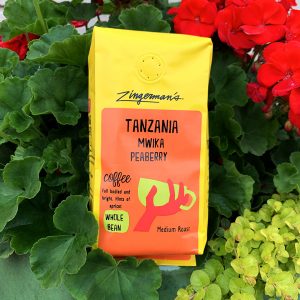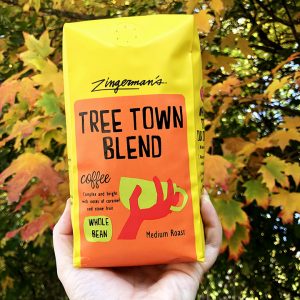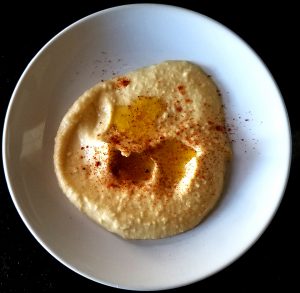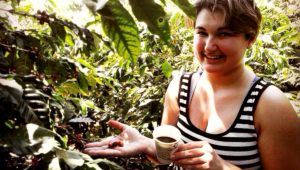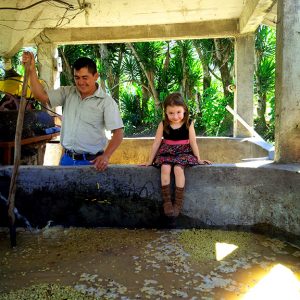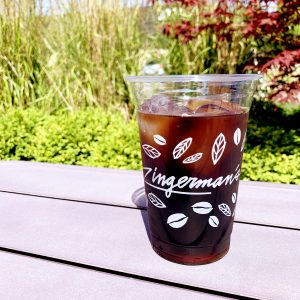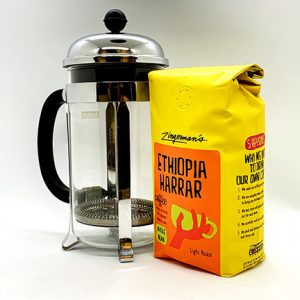New Single-Origin Coffee from Guatemala
A beautiful brew from the coffee-growing “star” of Central America
Ari Weinzweig, CEO & Co-Founder of Zingerman’s
Guatemala has an ancient and highly esteemed history that goes back to the advanced Mayan civilization dating to about 2000 BC. Coffee is a relatively recent arrival—serious commercial planting started in the middle of the 19th century, primarily with German immigrant planters, about a decade after the demise of a nation-state that almost no one around these parts will have heard of. The Federal Republic of Central America was founded in 1823—less that 50 years after the Declaration of Independence of the United States. The Federal Republic of Central America included what’s now Nicaragua, Costa Rica, El Salvador, Honduras, Chiapas and Guatemala. It started with much the same spirit as the U.S., as a democratic nation state, but came apart in the course of its own Civil War in 1938.
A century and a half down the road of history, Guatemala consistently produces some of the most flavorful coffee one can find anywhere. And some of the best of the best comes from an estate in the northern part of the country called “Los Dos Socios.” Here’s what the crew at the Coffee Company said:
The name was selected by Don Concepcion Villatoro Matias to refer to “the two associates” involved in producing coffee at his farm: himself and God. His approach has been a simple one since purchasing the farm in 1990: plant bourbon and caturra varietals under shade trees, tend them well, and keep parcels separated to maintain unique lots. His farm in Huehuetenango is up high with a view of the mountains, making for a lovely place to live and work. Huehuetenango is one of Guatemala’s prized coffee-growing regions, and with coffees as vibrant and exciting as this one, it’s easy to see why.
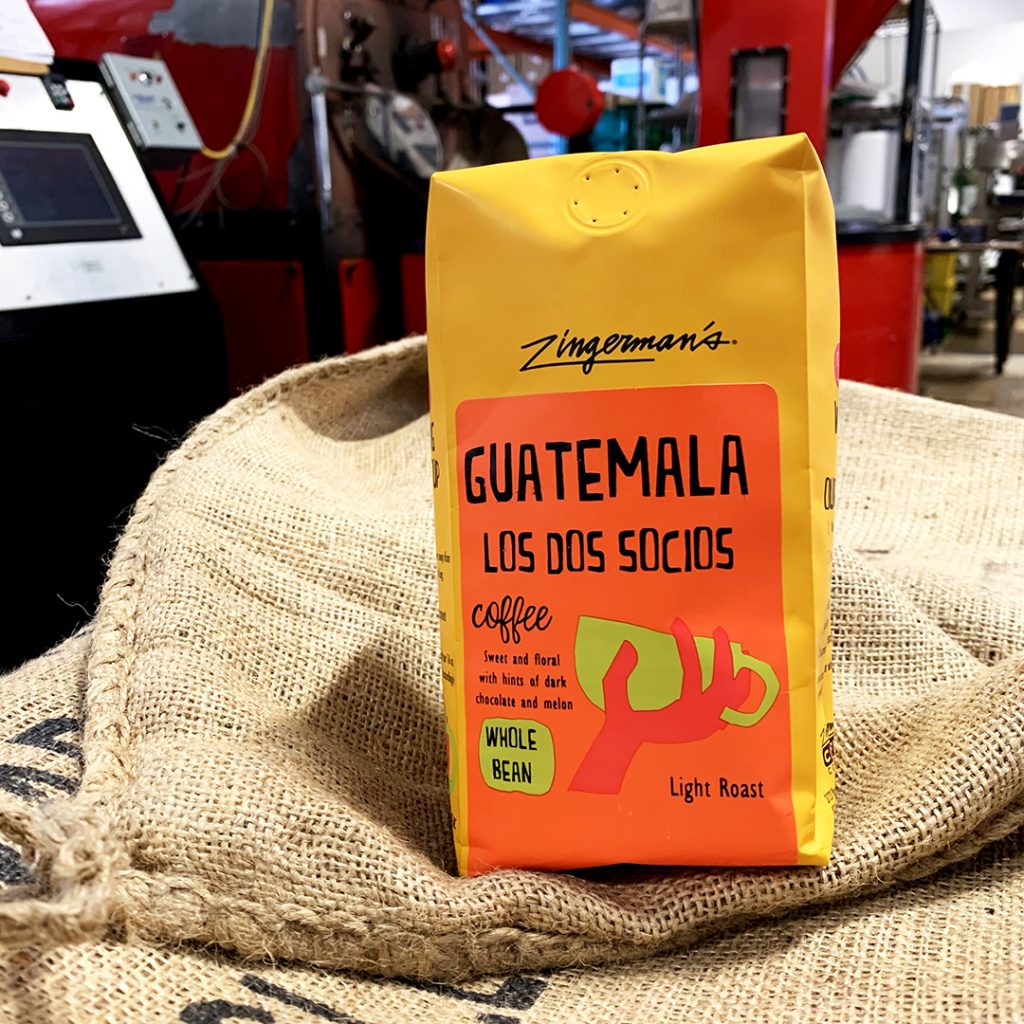
The flavor profile we’re getting out of Los Dos Socios is a thing of beauty: juicy blackberry notes, some really rich caramel smoothness, and a zing of bright papaya all working together. It reminds us of the coffee cherries we snacked on while visiting farms in Guatemala last year—the juicy, sweet, and tangy combination of flavors is a great way to describe the taste of the fruit surrounding a coffee bean. As long days of farm visits wore on, it was neat to see farmers picking a few cherries and snacking – even before it’s processed, roasted, and brewed, coffee can provide small moments to enjoy. We hope you appreciate all the hard work that went into these beans, and that you enjoy your brews of Los Dos Socios all the more for it!
I’ve been loving the coffee for the last few weeks. It’s got… a wonderful combination of depth and delicacy, substance and subtlety, softness and strength. It is, as per what I wrote above about vision, a positive and sustainable testament to the work of Don Concepcion and his team. There is something special, hard to pin down, that makes it so eminently calming, comforting and enjoyable. It has what Christopher Alexander wrote in The Timeless Way of Building: “In our lives, this quality without a name is the most precious thing we ever have.”
Come by the Coffee Company, the Deli, or Roadhouse and grab a bag of beans or a cup to go. Or let us ship—you won’t see it on the zingermans.com site, but email [email protected] and let us know what you’d like. Better still, sign up for a Mail Order Coffee Subscription!
P.S. If you’re at the Roadshow getting coffee, say hi to Celia who is from Guatemala, and proudly thanked me for carrying “her coffee.” I thank her for her great work and for bringing our vision and values alive every day in such beautiful ways!
Excerpt from Ari’s weekly Top 5 E-Newsletter. To stay in-the-know about things that Ari is excited about in the Zingerman’s family, sign up here!
Holiday Blend from the Coffee Company
A beautiful brew that can turn any day into a holiday!
Ari Weinzweig, CEO & Co-Founder of Zingerman’s
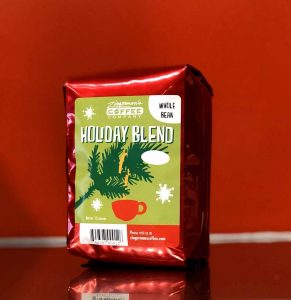
If you’re thinking about what to drink when you dive into a nice piece of pecan pie or with a toasted slice of Cranberry Pecan bread for breakfast, this seasonal brew from the Coffee Company could be just the trick.
We’ve been designing and offering an annual Holiday Blend for over a decade now—each year is a bit different to honor what’s best on the “green bean” market and the spirit of that particular season. This year, Steve (our longtime managing partner, and part of that Partners Group consensus), Matthew (the former staff partner I quoted above), and Chris (our roastmaster) have put together a trio of terrific beans for the blend.
Colombian ASPROBALBOA—From a coop of family farms near Balboa. It brings great high notes with hints of citrus and caramel to the blend.
Brazilian Espresso Blend #1—Sustainably grown, carefully processed, with big, well-rounded flavor.
Costa Rica—From the Hacienda Miramonte. It brings subtle sweetness and a rich, velvety body.
Each bean brings its own distinct flavor, and in the cup they come to a nice consensus on a single great flavor! Steve says, “The collection of coffees is representative of some of the best relationships we have—we know ALL of these producers personally and they are some of the longest standing relationships we have.” It would be safe to say that this year’s Holiday Blend is a beautiful homage to the support they have given us through the years! It’s got a full flavor, and a touch of nice astringency. It reminds me of the dark chocolate from the Dominican Republic that we’re getting from 9th & Larkin. True to the spirit of the 2020 season, it’s a bit darker than last year’s blend, but with notable hints of brightness and subtle floral notes. And, somehow, it seems to leave me feeling a bit more optimistic after I sip it.
Want to sign up for regular shipments of Zingerman’s Coffee? Check out Zingerman’s Coffee Club and the Zingerman’s Coffee Subscription at zingermans.com.
Available at the Coffee Company, Deli, Roadhouse, and Mail Order!
Excerpt from Ari’s weekly Top 5 E-Newsletter. To stay in-the-know about things that Ari is excited about in the Zingerman’s family, sign up here!
Winter Dine-In
As the weather gets chillier, we’d like to invite you in from the patio!
Please join us in the Cupping Lab behind the coffee bar, or feel free to enjoy the heated outdoor seating in the Zingerman’s Bakehouse courtyard just steps away from our door!
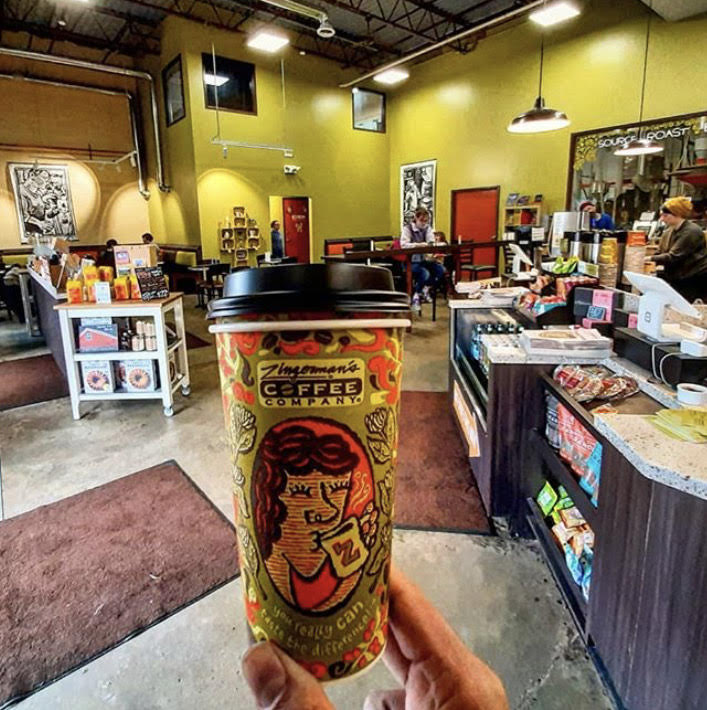
Additionally, we are required by the County Health Dept. to collect names, phone numbers, dates, and times of each dine-in guest. This will be required every time you come in, whether dining inside or outside. This information is collected in the event of contact tracing being necessitated, and it can happen one of two ways:
-Use your phone to scan the QR code that we have taped in front of the register and follow the prompts, or
-We can hand write it on our notepad!
To accommodate as many customers as we can safely, we’re asking that you stop by for no more than a half hour. At this time, we can only seat parties of 6 or less. Please wear a mask at all times except for when eating or drinking.
THANK YOU in advance for helping us keep a good thing goin’, safely. ❤️
Not ready to chill in our cafe? No worries!
We are still offering curbside delivery, contact-free pick-up, and home delivery.
Coffee’s Sixth Sense 🔮
A History of Fortune Telling and Family Tradition
By Michelle Abbey, Zingerman’s Coffee Company
The year is 1974. The setting is one startlingly bygone, culturally: a family living room, thick with cigarette smoke. Zingerman’s Coffee Company’s Managing Partner, Steve Mangigian, is 10 years old. After a meal together, Armenian coffee is not only served, but read. Steve recalls the female elders of his family flipping the contents of their cups onto saucers, scouring the grounds for images and their associated fortunes to emerge.
This is the story Steve consistently tells on his tours, during our “What is your first memory of coffee?” group icebreaker. “My parents needed a pot of Folgers to wake up.” is a common answer – I have yet to hear a guest share Steve’s experiences with family divination. He lights up; it’s a beloved childhood memory.
His experience while treasured is not unique. In fact, Steve isn’t the sole Armenian here in the small family of Zingerman’s Coffee Company! We’ve had a handful of Armenians come and go, and our Purchasing Manager, Laura, has Armenian roots.
“…She said it was extremely creepy and really hated the whole thing!”
The tradition in her family is remembered differently: “My mom talked about the tea leaf readings when she was a kid. This would have been the 1930’s. She remembers all the old Armenian ladies sitting in a circle bending over these cups and telling fortunes – they would tip them over into the saucers and read the leaves. She said it was extremely creepy and really hated the whole thing!”
The practice Steve and Laura describe in their families is called Tasseography: a divination or fortune-telling method that interprets patterns in tea leaves, coffee grounds, or wine sediments. The terms derive from the French word tasse (cup), which in turn derives from the Arabic loan-word into French tassa, and the Greek suffixes -graph (writing), -logy (study of), and -mancy (divination).
The practices’ origins can be traced back to medieval Europe. Fortune tellers read molten substances such as wax or lead. The method evolved into reading patterns of tea leaves after Dutch merchants introduced tea to Europe via trade routes to China. The tradition of coffee cup reading specifically is believed to have started in the 16th century when coffee made its way to the Ottoman Empire and the Middle East. The cultivation and distribution of coffee started in Ethiopia and moved from Yemen to the Arab trade and then to the Ottoman Empire. Armenians then popularized coffee in Europe.
Turkish coffee reading is very popular in Turkey and Greece. You can also find it in Russia and Eastern Europe, as well as Baltic and Middle Eastern countries.
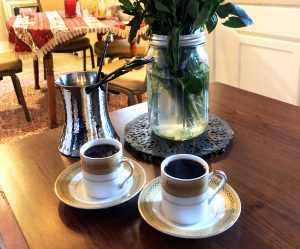
A traditional Ibric (kettle) and Armenian coffee cups. Note how the sides of the coffee cup do not slope down – this is necessary for proper grounds reading.
This tradition has gone by the wayside for some families, but the Mangigians are keeping it alive in their brood. Steve’s daughter, Bethanie, has taken over the tradition – but took her own route to get there.
“I actually wasn’t introduced to Armenian fortune-telling within my family, I wasn’t around it a lot as a kid.
“‘…’I see three men in your cup, encircling you.’ It was dead on, I had three orbiting at that time!”
I started doing this when I lived in New York. I was in college and took a course in Armenian history. I was first captivated by cup reading sitting in an ancient Armenian library. My professor did my first reading for me, it was startling and thrilling. She said, ‘I see three men in your cup, encircling you.’ It was dead on, I had three orbiting at that time! Should we include that?” she laughs.
Bethanie studied and lived abroad in the familial homeland of Armenia, with a host family. She got practice pulling cups with them, a family of artists.
“In their home and in the country itself, I was surrounded by beautiful imagery and architecture. There were beautiful symbols everywhere to inspire interpretations.”
It’s not just the cultural connection and experiences which draws Bethanie to cup reading.
“My mom uses the word ‘Kezba’, to describe this sixth sense that we have. And I work closely with people as a social worker and therapist. When you read cups, you have a connection with that person. I love this medium as a way to develop relationships with people. You cut through small talk to who they are, what their journey is. I can guide the reading, but people come up with their own interpretations, which is fascinating insight.”
Her eeriest experience?
“I did a cup reading at a party for a guy I had met just a week prior. We ended up dating later on, and the symbols I saw in his reading ALL appeared throughout our relationship. A chameleon was one symbol – it ended up being way too telling! This is why I prefer to read for strangers. Reading for friends can hit too close to home. You have to be prepared for what the cup says.”
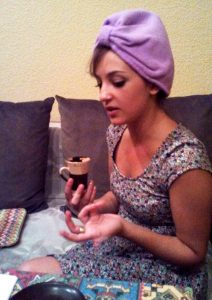
Bethanie hosts an Armenian Christmas party every year on January 6th, at her home in New Orleans. Her party favor giveaway is a drawing for someone to get a cup reading.
How do you read coffee, anyway? Simply drink your Armenian-style coffee in white china with no inside pattern or decoration. Shapes and patterns inside the coffee cup and on the saucer need to be visible for reading. After drinking most of the liquid in the coffee, cover the cup with the upside-down saucer and swirl three times. You wait for the grounds to fall from the bottom of the cup. This is why it is important to use the Armenian style espresso cup which is not rounded on the sides. The grounds fall down the sides of the espresso cup and dry at the bottom.
Put it down and allow a few minutes for the coffee to settle. Though it has some universally agreed rules, coffee cup reading is a very personal experience based upon on the “sixth sense”.
The type of coffee you use doesn’t really matter, just make sure it’s ground even finer than espresso and prepared, well, however your grandmother taught you to!
STEVE’S RECIPE:
- 8g coffee (Grind setting: 1 – finer than espresso, should feel like powder)
- 80g cold water
- 6g sugar
- 1 pinch of fresh ground cardamom OR
- 1 drop of rosewater
DIRECTIONS:
- Combine ingredients
- Bring to a boil and immediately
- Remove from heat
- Pour slowly to minimize the quantity of grounds in cup
Bethanie says this practice feels more precious in these times. “There’s a war against this small country [Armenia]. Holding onto these traditions feels even more important now. There are a lot of people I’m thinking about and worried about there right now.
“You may lose territory, but you can hang onto your culture.”
She wishes she could have been at the table with her Dad when her great aunt was telling fortunes. “It goes to show that these things need to be explicitly passed on, or you may lose them. You may lose territory, but you can hang onto your culture.”
Check out tasseography symbolism and best practices:
- https://coffeecupreadingsonline.com/divine-meanings-of-coffee-shapes/
- http://www.turkishstylegroundcoffee.com/turkish-coffee-reading/
—-
SOURCES:
- https://en.wikipedia.org/wiki/Tasseography
- https://coffeecupreadingsonline.com/divine-meanings-of-coffee-shapes/
- http://asbarez.com/174421/the-art-of-coffee-cup-reading-lives-on-through-a-new-generation/
- http://folklore.usc.edu/armenian-coffee-readings-ritual/
- http://www.digitaljournal.com/blog/16194
- http://elegantserenity.com/tasseography-art-tea-leaf-reading-future/
- http://www.turkishstylegroundcoffee.com/turkish-coffee-reading/
East African Peaberry from the slopes of Mount Kilimanjaro
Looking for something to sip while you nibble on a bit of the Gingerbread Cake?
Here’s a terrific coffee that makes a marvelous match.
Ari Weinzweig, CEO & Co-Founder of Zingerman’s
In the world of coffee producing countries, Tanzania is rarely the place that pops to the tip of any coffee drinker’s tongue. And yet, it’s got a fascinating coffee history and produces some delicious high grown beans that anyone with an eye and a mind for a high quality cup would want to have.
Coffee originated in ancient Abyssinia, what we now call Ethiopia. Sometime in the 16th century, coffee made its way south to what we know today as Tanzania. By comparison to what it took to get coffee to Costa Rica or Brazil, it was a quick trip—a modest 800 or 900 miles, almost directly due south. Within a century or so, coffee was incorporated into daily life and agriculture in the area by the people of the Haya tribe. Back then the beans weren’t brewed for drinking—instead they were boiled with herbs, then chewed to catch the buzz. Coffee growing was highly controlled by the royal families of the Haya (some things don’t change—hierarchies often build power by controlling money and drugs), and the plants were so highly prized that the beans were used as currency.
Three hundred years later, when German colonists conquered the country, they looked to coffee for cash, though more in the western sense—something to sell as an export. The colonial government gradually wrested control of the once closely guarded crop from the Haya royal families and started to spread coffee growing around the country. After WWI, Britain took charge of the region and worked to increase coffee production even further, while still carefully keeping the beans out of the control of traditional tribal powers. When Tanzania (a contraction of what had been two modern colonial states—Tanganyika and Zanzibar) gained independence in 1962, the former schoolteacher, Julius Nyerere became the new country’s prime minister. He too worked to expand coffee growing to help boost the economy. Nyerere had his issues and many of his attempts at modernization and equity went awry. He had a thing for state control that didn’t go so well and actually harmed the effectiveness of the coffee growing. But that said, the “Arusha Declaration” which he authored in 1967, has a lot of inspiring elements in it. He also humorously—and I would suggest accurately—once said, “Democracy is not a bottle of Coca-Cola which you can import. Democracy should develop according to that particular country.”
The Tanzanian coffee we’re getting today builds on all of that history, bringing beans from the slopes of the beautiful Mount Kilimanjaro on the border with Kenya to the north, all the way here to Ann Arbor. It’s a Peaberry—the mutation that yields a singular coffee bean inside each “cherry” fruit, rather than the usual two. We buy the beans from the Mwika North cooperative, established in 1984, one of the first sets of organic certified growers in the region. Volcanic soil and abundant rainfall make for particularly fine beans. It’s a washed coffee—the freshly picked cherries are soaked in water to remove the pulp and then the peaberry inside is dried on raised beds. The brewed cup is nicely full bodied with lovely little hints of apricot, blackberries, and semi-dark chocolate. I like it best in the Clever brewing at the Coffee Company, but it’s been darned good any way I’ve had it brewed. You can get the Tanzanian Peaberry every day this month at the Coffee Company, the Roadhouse and the Deli.
Excerpt from Ari’s weekly Top 5 E-Newsletter. To stay in-the-know about things that Ari is excited about in the Zingerman’s family, sign up here!
Tree Town Blend Coffee Beans
A fantastically flavorful cup of coffee that does the town proud
Ari Weinzweig, CEO & Co-Founder of Zingerman’s
Looking for a good coffee to perk up your mornings this month? Something to mark the start of September, welcome autumn, and sip while you watch the leaves start to change color? The 2020 release of our annual, early-autumn Tree Town Blend would be a particularly terrific way to do it. While the temperatures and the leaves slowly but surely start to fall, Tree Town is on the way up. Steve Mangigian, the Coffee Company’s managing partner, and I both agree—this year’s blend is better than ever!
Why “Tree Town”? Ann Arbor was founded in 1824, named for the wives of the village’s founders, both named Ann, and the stands of burr oak trees. That fall the U.S. held its 10th election for President. Voting lasted five weeks, from late October through December 1. No candidate won a majority of the votes and the election was turned over to Congress, where John Quincy Adams was elected. The “Tree Town” moniker derived over the years from the high volume of trees in the city. Until the arrival of Europeans, most of this part of the world—originally home to the Ojibwe people—was fully forested. But one of the first acts Europeans often engaged in was to take down large numbers of trees for timber, and then to plow virgin lands in order to farm—most of the city’s original trees were clear cut in the second half the 19th century to use for building here and for sale back east. Fortunately, early in the next century—around the time that Rocco Disderide built what’s now the Deli’s building back in 1902—the city embarked on a reforestation program. Given the positive impact that all those trees have on the aesthetics and ecology of the town, it seems that all of us who live here now ought to give those who led that project a big round of appreciation. The Tree Town blend is a celebration of that beauty.
Like the town for which it’s named, the Tree Town Blend is wonderfully well-rounded. And, as is true for Ann Arbor, its personality features contributions from caring sources from around the world—in this case, coffee beans Brazil, Guatemala, and Tanzania. The base is the Daterra espresso blend we get from the Pascoal family in Brazil. To that we’re adding coffee from a wonderful “crop to cup” lot we took possession of last month from Tanzania. And the whole thing is rounded out with some of that great Guatemala Esperanza (read more here…scroll down).
The result is a seriously tasty cup of coffee with a clean base of chocolate and caramel. It’s kind of cocoa-y, a bit nutty, remarkably smooth, and complex in a way that hints at dark plums. I’ve tried the Tree Town blend in all the brew methods at the Coffee Company and all have been pretty terrific. The Clever brewing was my favorite, but test them out and see what you like. You can drink a lot of it. As Steve says, “It’s not overpowering, and you could sip it long and slow all day. I love it.”
The Tree Town Blend is available at the Coffee Company on Plaza Drive, at the Deli, and at the Roadhouse (come sit outside at any or all of them and sip away)! Or ship some of this very special coffee to anyone who would appreciate a little taste of Ann Arbor!
Excerpt from Ari’s weekly Top 5 E-Newsletter. To stay in-the-know about things that Ari is excited about in the Zingerman’s family, sign up here!
Crafting Coffee, Curbing Covid: Checking in with Barista Becca
We’re in “these times” together, but our experiences are unique and personal.
In this new series, we’ll be checking in with the friendly folks who bring your favorite joe to life – the Zingerman’s Coffee Co. team – to see what the “new normal” means for them.
Name: Becca
Years at Zingerman’s Coffee Company: 3
Role: Barista
Q: You are our global traveler who’s usually jetting off across the world. How are you dealing right now?
A: Handling wanderlust in the age of Covid is a challenge I have no choice but to accept. In these times, I feel grateful for all of the traveling I have pursued thus far. While I long to give my freshly-renewed passport some well-deserved love, I have been exploring the Great Lakes State instead. I visited the Warren Sand Dunes for the first time recently, and will visit Sleeping Bear Dunes soon.
Something that I have always loved about this country is how multicultural it is. By recommendation of a fellow ZCoBer, I recently visited ZZ’s Market on Packard in search of tahini. They were out, but every person in there had a different accent, and one man suggested Aladdin’s Market, just past the light. I thanked him and made my way over. The owner of Aladdin’s helped me with my hummus recipe and gave me a sample of his product, saying ‘try to make yours taste like this’. Needless to say, my first batch of hummus turned out pretty tasty.
Q: I have to ask!: Have you been to any of the coffee-growing countries?
A: Yes! I took a vacation to Panamá, and happened to make the acquaintance of a coffee producer there who invited my friends and I to his farm. He gave us a demo on how to pick beans, explained how different woods burn at different temperatures and which are good for roasting, and of course let us taste some coffee! I ran over to my friends saying how naturally sweet the coffee was. They were in disbelief until they tried it themselves.
Q: Back home here at Coffee, what’s your favorite bean/brew method combo?
A: My favorite brew method we carry is the press pot; I like my coffee less filtered. It pairs great with the new Peru. I will say I miss every Mexican coffee we’ve sourced and would love to see a comeback.
High-Grown Honduras Coffee from Farmer Pablo Paz
A University of Michigan student project pays delicious dividends a decade down the road
Ari Weinzweig, CEO & Co-Founder of Zingerman’s
It’s about ten years ago now that U of M alum Andrew Boyd approached me. He wanted to tell me about a new project he and some other recent graduates were getting into. Their idea was to work with quality-oriented specialty coffee growers in Honduras to enable the farmers to sell their beans for a much higher price and free themselves from the mass market’s unmanageable price swings. By having us roast the coffee and sell it here at Zingerman’s, he suggested, we could bring it back home to Ann Arbor—whence this wonderful project originated. A decade down the road, I can confidently say the project with the company Andrew and his colleagues call Union Microfinanza is going strong. The Honduran coffee this year is better than ever—right now it’s featured as the Coffee of the Month. The crew at the Coffee Company says it’s “floral and juicy, with notes of cocoa.” I agree. Add maybe a touch of toffee or toasted walnuts. And I’ll say too that the finish is cleaner and smoother than ever. I loved the clarity I got when it was brewed as a Chemex. As our partner at the Coffee Company, Steve Mangigian, shared, “It shows that when you work with the producer year after year, and when everyone is committed to quality, it gets better and better each year.”
The land of the nation-state now known as Honduras has been inhabited for thousands of years by various native tribes, including a strong presence of Maya (the border to the north is Guatemala). Europeans arrived at the end of July 1502. Columbus named it Honduras, which means “depths,” for the deep waters of the harbor. Native tribes fought back against the Spanish for much of the 16th century and maintained a fair bit of freedom from European colonizers through the 17th century. In the 17th century, a number of Africans destined for enslavement escaped from slave ships that had wrecked on Honduras’ rocky Gulf coast. Many intermarried with native peoples and their descendants came to be known as the Miskito people. By the end of the 18th century, the Miskito kingdom was quite well established. They had an interesting and very egalitarian culture—Miskito kings sat on the throne, but all members of the kingdom were considered to be equal and the kings had very little power unless the kingdom was being attacked. In one of those seeming incongruities and complexities that make historical oversimplification inevitably ineffective, the Miskito often raided other territories and sold their captives to the English as slaves to be brought to work in the Caribbean sugar fields.
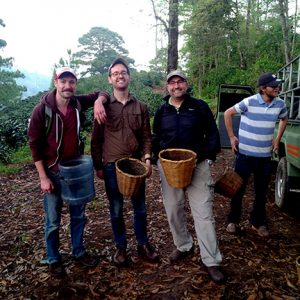
Chris, Matthew, and Managing Partner Steve Mangigian picking coffee cherries in Honduras, during the the trip to origin in 2015.
If you look at a map, you’ll find Honduras lies at about the midpoint of Central America, nestled nicely between Nicaragua to the east, Guatemala to the west, and El Salvador to the south. Coffee came to the area in the late 19th century, but since bananas remained the big colonial cash crop, coffee got little attention. Coffee for high-quality export really only started up in the years after we opened the Deli in 1982. Before that, the best Honduran beans were sold across the border and repacked as Guatemalan coffee in the same way that olive oil from North Africa was long shipped to Italy and re-packaged there.
A crew from the Coffee Company flew down to Honduras back in the winter of 2015 to visit. The farmer, Pablo Paz, won their hearts with his commitment to quality, his family’s five generations in coffee growing, and his interest in learning and continuous improvement. The crew shared: “Long before many folks in the specialty coffee world were paying a premium for high-quality beans or taking trips to remote areas of the world to source rare and distinct micro-lots, growing fantastic coffee was just how the Paz family operated, and we’re so lucky to have developed a relationship with him.” Pablo’s farm is located in the hills outside the town of La Union, in the highlands, in the center of the country. The town is doing well, in great part thanks to the attention and income that comes from being a central point for high-quality coffee.
Pablo Paz’s Honduran beans brew up in what I would suggest is an exceptionally egalitarian cup—a set of more forward flavor notes for those who like their coffee on the bolder side, yet simultaneously soft enough for people like me who prefer their brew to be mellower. You can get Pablo Paz’s Honduran coffee at the Coffee Company, Deli, and Roadhouse!
Excerpt from Ari’s weekly Top 5 E-Newsletter. To stay in-the-know about things that Ari is excited about in the Zingerman’s family, sign up here!
Kyoto Cold Brew Coffee
400 years of Japanese tradition and 10 hours of patience add up to one smooth cup of cold brew coffee.
What is Kyoto Cold Brew Coffee?
Kyoto-style cold brew coffee is made by letting cold water slowly drip, drop by drop, over coffee grounds. Kyoto cold brew, or Kyoto drip coffee, is also known around the world as Dutch coffee, ice drip coffee, cold drip coffee, and water drip coffee. It is documented as far back as the 1600s in Japan, where it’s believed the method was introduced by Dutch traders who brought cold brew on their ships.
Kyoto Is Cool
The traditional Kyoto drip method, like all cold brew coffee, is made using cool water instead of hot water. The use of cool water changes the balance of flavors extracted from the coffee grounds during brewing. Kyoto drip coffee barely oxidizes, which makes it easy to taste the subtlest flavors and nuances of single origin coffees. It is an especially good brewing method for lighter-roasted coffees, as it preserves the nuances and bright, fruit-like flavors of more delicately roasted, complex beans.
The sight of a Kyoto-style brewer is something to behold! The four foot tall wood and glass tower is a cross between an elegant hourglass and an intriguing chemistry set. It has three sections: the water chamber on top, the column of coffee grounds and filter in the middle, and the carafe at the base. And, you get to drink the experiment with no dire (only delicious) consequences!
Zingerman’s Coffee Company guests will have the chance to try Kyoto Cold Brew for a limited time. We have our very own Kyoto brewer, and will offer this unique cold brew for the whole month of August – exclusively in our Southside cafe!
Kyoto Cold Brew at the Zingerman’s Coffee Café
- 300g coffee beans, ground medium-coarse
- 3000g cold-filtered water
- 1 drip per second
- Duration: 10 hours
- Final product is served over ice, your choice of short or tall!
Other Cold-Brewed Coffee Options
For those who’d like to taste their way through Zingerman’s cold coffee offerings after they try Kyoto Cold Brew, we recommend sampling Zingerman’s Cold Brew and Nitro Cold Brew.
- Zingerman’s Cold Brew is brewed by completely submerging coarse ground coffee in cool water for 12 or more hours, which results in a finish with less acidity than Kyoto Cold Brew.
- Next, try our nitro cold brew, which is Zingerman’s Cold Brew infused with nitrogen gas and served on tap. Nitro cold brew has a rich, creamy head you may recognize from nitro draft beers like Guinness.
Curious about Coffee? Sign up for our monthly e-newsletter to be the first to know about classes, events, new coffees, and more!
A Zingerman’s Coffee cafe – in your kitchen!
AVAILABLE KITS:
- Aeropress
- Steeps coffee for 10–50 seconds, and then forces through a filter by pressing the plunger through the tube. Short and sweet, and extracts extra flavor.
- Includes: Aeropress brewer and your choice of beans (our suggestion: Colombia Asprobalboa – juicy, smooth body, nutty notes).
- French Press
- Ground beans are infused and then pressed to the bottom by means of a plunger. Coffee in its purest form!
- Includes: French Press brewer and your choice of beans (our suggestion: Ethiopia Harrar: tea-like, lemon, and blueberry).
- Chemex
- A variation of the pour-over. Chemex paper filters are 20-30% heavier than other filters, and retain more oils and solids – resulting in the cleanest cup of coffee you can get!
- Includes: Chemex brewer, filters, and your choice of beans (our suggestion: French Roast – smokey, caramel, tobacco).
- Clever
- Combines pour-over and immersion brewing to consistently produce a clean and well-extracted cup.
- Includes: Clever brewer, filters, and yoiur choice of beans (our suggestion: Roadhouse Joe – toasty marshmallow and cocoa).
- Pourover
- Water is poured over and through the grounds to extract the coffee flavors. The most common and familiar brewing method – a great place to start from if you’re just getting into hand brewing!
- Includes: v60 cone brewer, range server, arm stand, filters, and your choice of beans (our suggestion: Costa Rica Hacienda Miramonte -a balanced, sweet cup, with a honey-like body).
- Coffeemaker
- Easy peasy! Does the work for you. The 8 Cup Bonavita Coffee Brewer has a thermal caraffe and is recognized by the Specialty Coffee Association of America as part of its certified home brewer program.
- Includes: coffee maker, filters, and your choice of beans (our suggestion: Detroit Street Decaf – perfectly balanced, with a little floral in the nose and good body).
For your inspiration and caffeination, we are also offering kits with your choice of Zingerman’s coffee beans, a Zingerman’s coffee logo mug, and your choice of book or pamphlet authored by Zingerman’s co-founder Ari Weinzweig.
Give us a call at (734) 929-6060 to order yours for curbside pick-up, or order online with Snackpass for contact-free pick-up in our cafe!



